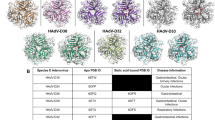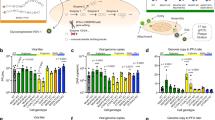Abstract
Adenovirus type 37 (Ad37) is a leading cause of epidemic keratoconjunctivitis (EKC)1,2, a severe and highly contagious ocular disease. Whereas most other adenoviruses infect cells by engaging CD46 or the coxsackie and adenovirus receptor (CAR), Ad37 binds previously unknown sialic acid–containing cell surface molecules3,4. By glycan array screening, we show here that the receptor-recognizing knob domain of the Ad37 fiber protein specifically binds a branched hexasaccharide that is present in the GD1a ganglioside and that features two terminal sialic acids. Soluble GD1a glycan and GD1a-binding antibodies efficiently prevented Ad37 virions from binding and infecting corneal cells. Unexpectedly, the receptor is constituted by one or more glycoproteins containing the GD1a glycan motif rather than the ganglioside itself, as shown by binding, infection and flow cytometry experiments. Molecular modeling, nuclear magnetic resonance and X-ray crystallography reveal that the two terminal sialic acids dock into two of three previously established sialic acid–binding sites in the trimeric Ad37 knob. Surface plasmon resonance analysis shows that the knob–GD1a glycan interaction has high affinity. Our findings therefore form a basis for the design and development of sialic acid–containing antiviral drugs for topical treatment of EKC.
This is a preview of subscription content, access via your institution
Access options
Subscribe to this journal
Receive 12 print issues and online access
$209.00 per year
only $17.42 per issue
Buy this article
- Purchase on Springer Link
- Instant access to full article PDF
Prices may be subject to local taxes which are calculated during checkout




Similar content being viewed by others
References
Wold, W.S.M. & Horwitz, M.S. Adenoviruses. in Fields Virology, Vol. 2 (eds. Knipe, D.M. & Howley, P.M.) 2395–2436. (Lippincott Williams & Wilkins, Philadelphia, 2007).
Ford, E., Nelson, K.E. & Warren, D. Epidemiology of epidemic keratoconjunctivitis. Epidemiol. Rev. 9, 244–261 (1987).
Arnberg, N. Adenovirus receptors, implications for tropism, treatment and targeting. Rev. Med. Virol. 19, 165–178 (2009).
Arnberg, N., Edlund, K., Kidd, A.H. & Wadell, G. Adenovirus type 37 uses sialic acid as a cellular receptor. J. Virol. 74, 42–48 (2000).
Gordon, Y.J., Aoki, K. & Kinchington, P.R. Adenovirus keratoconjunctivitis. in Ocular Infection and Immunity (eds. Pepose, J.S., Holland, G.N. & Wilhelmus, K.R.) 877–894. (Mosby, St. Louis, 1996).
Kinchington, P.R., Romanowski, E.G. & Gordon, Y.J. Prospects for adenovirus antivirals. J. Antimicrob. Chemother. 55, 424–429 (2005).
Arnberg, N. et al. Adenovirus type 37 binds to cell surface sialic acid through a charge-dependent interaction. Virology 302, 33–43 (2002).
Arnberg, N., Pring-Akerblom, P. & Wadell, G. Adenovirus type 37 uses sialic acid as a cellular receptor on Chang C cells. J. Virol. 76, 8834–8841 (2002).
Wu, E. et al. Membrane cofactor protein is a receptor for adenoviruses associated with epidemic keratoconjunctivitis. J. Virol. 78, 3897–3905 (2004).
Cashman, S.M., Morris, D.J. & Kumar-Singh, R. Adenovirus type 5 pseudotyped with adenovirus type 37 fiber uses sialic acid as a cellular receptor. Virology 324, 129–139 (2004).
Lecollinet, S. et al. Improved gene delivery to intestinal mucosa by adenoviral vectors bearing subgroup B and D fibers. J. Virol. 80, 2747–2759 (2006).
Thirion, C. et al. Adenovirus vectors based on human adenovirus type 19a have high potential for human muscle-directed gene therapy. Hum. Gene Ther. 17, 193–205 (2006).
Arnberg, N., Kidd, A.H., Edlund, K., Olfat, F. & Wadell, G. Initial interactions of subgenus D adenoviruses with A549 cellular receptors: sialic acid versus αv integrins. J. Virol. 74, 7691–7693 (2000).
Rinaldi, S. et al. Analysis of lectin binding to glycolipid complexes using combinatorial glycoarrays. Glycobiology 19, 789–796 (2009).
Mayer, M. & Meyer, B. Characterization of ligand binding by saturation transfer difference NMR spectroscopy. Angew. Chem. Int. Ed. 38, 1784–1788 (1999).
Burmeister, W.P., Guilligay, D., Cusack, S., Wadell, G. & Arnberg, N. Crystal structure of species D adenovirus fiber knobs and their sialic acid binding sites. J. Virol. 78, 7727–7736 (2004).
Bewley, M.C., Springer, K., Zhang, Y.B., Freimuth, P. & Flanagan, J.M. Structural analysis of the mechanism of adenovirus binding to its human cellular receptor, CAR. Science 286, 1579–1583 (1999).
Persson, B.D. et al. Adenovirus type 11 binding alters the conformation of its receptor CD46. Nat. Struct. Mol. Biol. 14, 164–166 (2007).
Kirby, I. et al. Identification of contact residues and definition of the CAR-binding site of adenovirus type 5 fiber protein. J. Virol. 74, 2804–2813 (2000).
Sauter, N.K. et al. Hemagglutinins from two influenza virus variants bind to sialic acid derivatives with millimolar dissociation constants: a 500-MHz proton nuclear magnetic resonance study. Biochemistry 28, 8388–8396 (1989).
Arnberg, N., Mei, Y. & Wadell, G. Fiber genes of adenoviruses with tropism for the eye and the genital tract. Virology 227, 239–244 (1997).
Lenaerts, L., De Clercq, E. & Naesens, L. Clinical features and treatment of adenovirus infections. Rev. Med. Virol. 18, 357–374 (2008).
von Itzstein, M. et al. Rational design of potent sialidase-based inhibitors of influenza virus replication. Nature 363, 418–423 (1993).
Kim, C.U. et al. Influenza neuraminidase inhibitors possessing a novel hydrophobic interaction in the enzyme active site: design, synthesis, and structural analysis of carbocyclic sialic acid analogues with potent anti-influenza activity. J. Am. Chem. Soc. 119, 681–690 (1997).
Johansson, S.M. et al. Multivalent sialic acid conjugates inhibit adenovirus type 37 from binding to and infecting human corneal epithelial cells. Antiviral Res. 73, 92–100 (2007).
Araki-Sasaki, K. et al. An SV40-immortalized human corneal epithelial cell line and its characterization. Invest. Ophthalmol. Vis. Sci. 36, 614–621 (1995).
Tsai, B. et al. Gangliosides are receptors for murine polyoma virus and SV40. EMBO J. 22, 4346–4355 (2003).
Boffey, J. et al. Characterisation of the immunoglobulin variable region gene usage encoding the murine anti-ganglioside antibody repertoire. J. Neuroimmunol. 165, 92–103 (2005).
Kabsch, W. Automatic processing of rotation diffraction data from crystals of initially unknown symmetry and cell constants. J. Appl. Crystallogr. 26, 795–800 (1993).
McCoy, A.J. et al. Phaser crystallographic software. J. Appl. Crystallogr. 40, 658–674 (2007).
Collaborative Computational Project. The CCP4 suite: programs for protein crystallography. Acta Crystallogr. D Biol. Crystallogr. 50, 760–763 (1994).
Murshudov, G.N., Vagin, A.A. & Dodson, E.J. Refinement of Macromolecular Structures by the Maximum-Likelihood Method. Acta Crystallogr. D Biol. Crystallogr. 53, 240–255 (1997).
Emsley, P. & Cowtan, K. Coot: model building tools for molecular graphics. Acta Crystallogr. D Biol. Crystallogr. 60, 2126–2132 (2004).
Adams, P.D. et al. PHENIX: a comprehensive Python-based system for macromolecular structure solution. Acta Crystallogr. D Biol. Crystallogr. 66, 213–221 (2010).
Acknowledgements
We highly appreciate the support from F. Lindh and S. Spjut regarding the purification of GD1a glycan; F. Lindh (Isosep) provided GD1a gangliosides. We also thank A. Carlsson (Medigelium) for providing GD1a-containing liposomes; D. Guilligay (EMBL) for providing the Ad37 knob gene cloned into pPROEX Htb plasmid (Life Technologies)16; R.L. Schnaar (The Johns Hopkins University School of Medicine) for providing P4 compounds; and K. Lindman, M. Hägg and F. Jamshidi for technical support. HCE cells were provided by K. Araki-Sasaki (Kinki Central Hospital). GM3 and GD2 glycans were provided by the Consortium for Functional Glycomics. We also highly appreciate the resources provided by the Consortium for Functional Glycomics (funded by National Institute of General Medical Sciences grant no. GM62116) Core D and H, as well as related technical support from O. Blixt and N. Reza. We are grateful to the Berlin Electron Storage Ring Society for Synchrotron Radiation (BESSY) for beamtime and beamline support. This project was supported by the Swedish Research Council (grants no. 2007-3402 (N.A.); 2009-3859 (N.A.) and 11612 (J.Å. via M.E. Breimer)), the Swedish Foundation for Strategic Research (grant no. F06-0011 to N.A.), the Swedish Society of Medicine (grant no. 97031 to N.A.), the Estonian Science Foundation (grant 8300 to A.L.), the Collaborative Research Center SFB-685 (T.S.), a student fellowship from the University of Tübingen (J.B.) and The Wellcome Trust (S.R. and H.J.W.).
Author information
Authors and Affiliations
Contributions
E.C.N. and R.J.S. contributed equally to design and conduction of binding, infection and flow cytometry experiments; S.M.C.J. produced GD1a glycan and performed NMR studies with M.H.; J.B. and T.S. carried out X-ray crystallography studies; S.R. and H.J.W. performed combinatorial glycolipid glycoarray; J.Å. conducted molecular modeling; F.P.D. carried out immunohistochemistry analysis; and A.L. performed SPR experiments. L.F. and T.L.E. conducted two-dimensional gel electrophoresis and blotting experiments, and L.F. did statistical calculations. T.S., M.H., F.P.D., A.L., J.Å., H.J.W., L.F., J.B. and N.A. discussed and wrote the manuscript, and T.S. and N.A. supervised the project.
Corresponding author
Ethics declarations
Competing interests
The authors declare no competing financial interests.
Supplementary information
Supplementary Text and Figures
Supplementary Figures 1–6 and Supplementary Tables 2–5 (PDF 4855 kb)
Supplementary Table 1
Summary of glycan array data (XLS 119 kb)
Rights and permissions
About this article
Cite this article
Nilsson, E., Storm, R., Bauer, J. et al. The GD1a glycan is a cellular receptor for adenoviruses causing epidemic keratoconjunctivitis. Nat Med 17, 105–109 (2011). https://doi.org/10.1038/nm.2267
Received:
Accepted:
Published:
Issue Date:
DOI: https://doi.org/10.1038/nm.2267
This article is cited by
-
Material-engineered bioartificial microorganisms enabling efficient scavenging of waterborne viruses
Nature Communications (2023)
-
Broad sialic acid usage amongst species D human adenovirus
npj Viruses (2023)
-
Human adenovirus binding to host cell receptors: a structural view
Medical Microbiology and Immunology (2020)
-
Diversity within the adenovirus fiber knob hypervariable loops influences primary receptor interactions
Nature Communications (2019)



